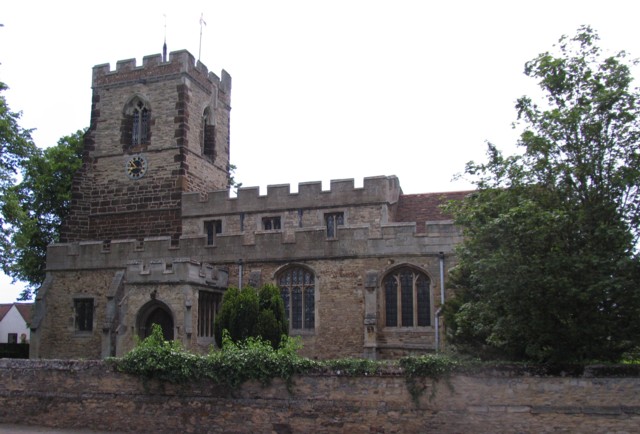Church Of All Saints, Cople on:
[Wikipedia]
[Google]
[Amazon]
 Church of All Saints is a
Church of All Saints is a
Official website
Church of England church buildings in Bedfordshire Christ Church, Oxford Grade I listed churches in Bedfordshire All Saints {{England-church-stub
 Church of All Saints is a
Church of All Saints is a Grade I listed
In the United Kingdom, a listed building is a structure of particular architectural or historic interest deserving of special protection. Such buildings are placed on one of the four statutory lists maintained by Historic England in England, Hi ...
church in Cople, Bedfordshire
Bedfordshire (; abbreviated ''Beds'') is a Ceremonial County, ceremonial county in the East of England. It is bordered by Northamptonshire to the north, Cambridgeshire to the north-east, Hertfordshire to the south and the south-east, and Buckin ...
, England. It became a listed building on 13 July 1964. The church, dedicated to All Saints, is constructed of sandstone
Sandstone is a Clastic rock#Sedimentary clastic rocks, clastic sedimentary rock composed mainly of grain size, sand-sized (0.0625 to 2 mm) silicate mineral, silicate grains, Cementation (geology), cemented together by another mineral. Sand ...
and Dunstable clunch
Clunch is a traditional building material of chalky limestone rock used mainly in eastern England and Normandy. Clunch distinguishes itself from archetypal forms of limestone by being softer in character when cut, and may resemble chalk in lowe ...
, in the Early English Period
English Gothic is an architectural style that flourished from the late 12th until the mid-17th century. The style was most prominently used in the construction of cathedrals and churches. Gothic architecture's defining features are pointed a ...
and Perpendicular
In geometry, two geometric objects are perpendicular if they intersect at right angles, i.e. at an angle of 90 degrees or π/2 radians. The condition of perpendicularity may be represented graphically using the '' perpendicular symbol'', � ...
styles. It contains a chancel
In church architecture, the chancel is the space around the altar, including the Choir (architecture), choir and the sanctuary (sometimes called the presbytery), at the liturgical east end of a traditional Christian church building. It may termi ...
with side chapels, nave
The nave () is the central part of a church, stretching from the (normally western) main entrance or rear wall, to the transepts, or in a church without transepts, to the chancel. When a church contains side aisles, as in a basilica-type ...
with clerestory
A clerestory ( ; , also clearstory, clearstorey, or overstorey; from Old French ''cler estor'') is a high section of wall that contains windows above eye-level. Its purpose is to admit light, fresh air, or both.
Historically, a ''clerestory' ...
, aisles, south porch and a tower containing 6 bells (it had 5 bells until the mid 20th c when the sixth was added, the pub next to the church is still called The Five Bells). The bells are regularly rang for church services and weddings but sadly not on Christmas Eve after complaints from a near neighbour stopped the near 250 year tradition of the bells ringing out to the village to welcome the celebrations of the birth of Christ. Bell ringing practice is undertaken on a Wednesday evening between 7:30 to 8:45 (correct in March 2025) with visitors welcome to try or sit and watch. The bells are uncommon in the fact the ring of the bells is to the right and not the more traditional left with bands of ringers coming far and wide to visit the tower to ring the bells in what is considered backwards. The tower clock has one face to the south side of the building with little attention taken as the clock is normally a little behind the time in London but a little ahead of the time in Plymouth. An earlier large sun dial is set into the same south wall which would have been the original time piece of the village. On the north side of the chancel, there are two marble altar tombs, one to Walter Luke, 1544, and wife Anne Launcelyn, 1538, the brass retaining
traces of inlaid colour, other of C16 with brasses to Thomas Grey and Benet (Launcelyn) his wife, and their sons and daughters. Chancel floor has brass to John Launcelyn and wife Margaret, 1435, reusing C14 brass (F.W. Kuhlicke,"A Palimpsest Brass at Cople" The nave and chancel have been restored since 1877. The register dates from the year 1560. Its patron was Christ Church, Oxford
Christ Church (, the temple or house, ''wikt:aedes, ædes'', of Christ, and thus sometimes known as "The House") is a Colleges of the University of Oxford, constituent college of the University of Oxford in England. Founded in 1546 by Henry V ...
.
See also
*Grade I listed buildings in Bedfordshire
There are approximately 372,905 listed buildings in England and 2.5% of these are Grade I. This page is a list of these buildings in the county of Bedfordshire,http://www.heritagegateway.org.uk/Gateway/Advanced_Search.aspx?reset=true Englis ...
References
* ''This article includes text incorporated from E.R. Kelly's "Kelly's directory of Bedfordshire, Hunts and Northamptonshire." (1885), a publication now in the public domain.''External links
Official website
Church of England church buildings in Bedfordshire Christ Church, Oxford Grade I listed churches in Bedfordshire All Saints {{England-church-stub